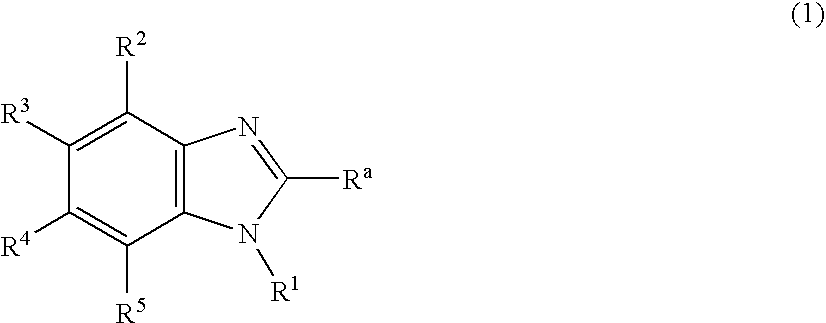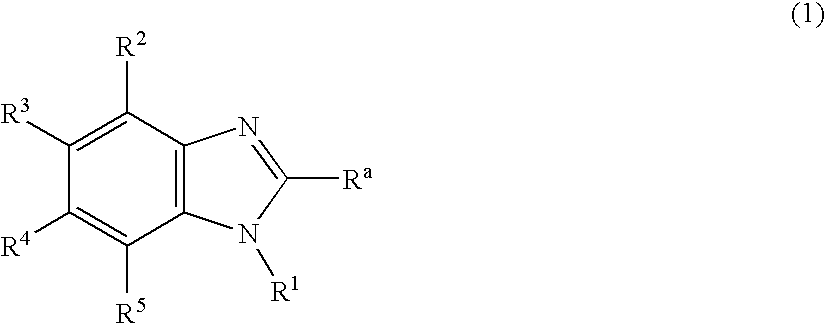Nitrogen-containing heterocyclic derivatives and organic electroluminescence device using the same
- Summary
- Abstract
- Description
- Claims
- Application Information
AI Technical Summary
Benefits of technology
Problems solved by technology
Method used
Image
Examples
synthesis example 1
(1-3) Synthesis Example 1
Synthesis of Compound (1)
[0195]
[0196] In a stream of argon, 6.7 g (16 mmol) of Intermediate 2, 6.0 g (17 mmol) of 10-naphthalen-2-yl-anthracene-9-boronic acid, 0.36 g (0.31 mmol) of tetrakis(triphenylphosphine)palladium(0), 50 mL of 1,2-dimethoxyethane, and 26 mL (52 mmol) of a 2-M aqueous solution of sodium carbonate were added to a 300-mL three-necked flask, and the whole was refluxed under heat for 8 hours. After the completion of the reaction, dichloromethane was added, and the organic layer was sufficiently washed with water and dried with magnesium sulfate. After that, the solvent was removed by distillation with a rotary evaporator. The resultant coarse crystal was washed with 50 ml of toluene and 100 mL of methanol, whereby 3.5 g of a pale yellow powder were obtained. The powder was identified as Compound (1) by field desorption mass spectrometry (FD-MS) (49% yield).
synthesis example 2
Synthesis of Compound (2)
[0197] (2-1) Synthesis of Intermediate 3
[0198] 5.0 g (25 mmol) of 2-phenylbenzoic acid were suspended in 50 mL of 1,2-dichloroethane. 4.6 g (39 mmol) of thionyl chloride and three drops of DMF were added to the suspension, and the whole was stirred under heat at 50° C. for 1 hour. After the solvent had been removed by distillation with a rotary evaporator, the remainder was dissolved in 80 mL of N-methylpyrrolidone. 6.6 g (25 mmol) of N-(4-bromophenyl)-1,2-phenylenediamine were added to the solution, and the whole was stirred at room temperature for 3 hours. After the completion of the reaction, the reaction mixture was loaded into 300 mL of water, and the precipitated solid was separated by filtration and dried under reduced pressure, whereby 10.4 g of Intermediate 1 were obtained in 94% yield.
[0199] (2-2) Synthesis of Intermediate 4
[0200] 10.4 g (31 mmol) of Intermediate 2 were dissolved in 80 mL of xylene. 0.44 g (2.3 mmol) of p-toluenesulfonic acid mo...
example 1 (
Production of Organic EL Device using the Compound of the Present Invention in its Electron Transporting Layer)
[0203] A glass substrate measuring 25 mm wide by 75 mm long by 1.1 mm thick and provided with an ITO transparent electrode (anode) (manufactured by GEOMATEC Co., Ltd.) was subjected to ultrasonic cleaning in isopropyl alcohol for 5 minutes. After that, the resultant was subjected to UV ozone cleaning for 30 minutes. The glass substrate provided with a transparent electrode line after the cleaning was mounted on a substrate holder of a vacuum deposition device, and, first, an N,N′-bis(N,N′-diphenyl-4-aminophenyl)-N,N-diphenyl-4,4′-diamino-1,1-biphenyl film (hereinafter abbreviated as “TPD232 film”) having a thickness of 60 nm was formed on the surface on the side where the transparent electrode line was formed so as to cover the transparent electrode. The TPD232 film functions as a hole injecting layer. Subsequent to the formation of the TPD232 film, a 4,4′-bis[N-(1-naphthyl...
PUM
 Login to View More
Login to View More Abstract
Description
Claims
Application Information
 Login to View More
Login to View More - R&D
- Intellectual Property
- Life Sciences
- Materials
- Tech Scout
- Unparalleled Data Quality
- Higher Quality Content
- 60% Fewer Hallucinations
Browse by: Latest US Patents, China's latest patents, Technical Efficacy Thesaurus, Application Domain, Technology Topic, Popular Technical Reports.
© 2025 PatSnap. All rights reserved.Legal|Privacy policy|Modern Slavery Act Transparency Statement|Sitemap|About US| Contact US: help@patsnap.com



